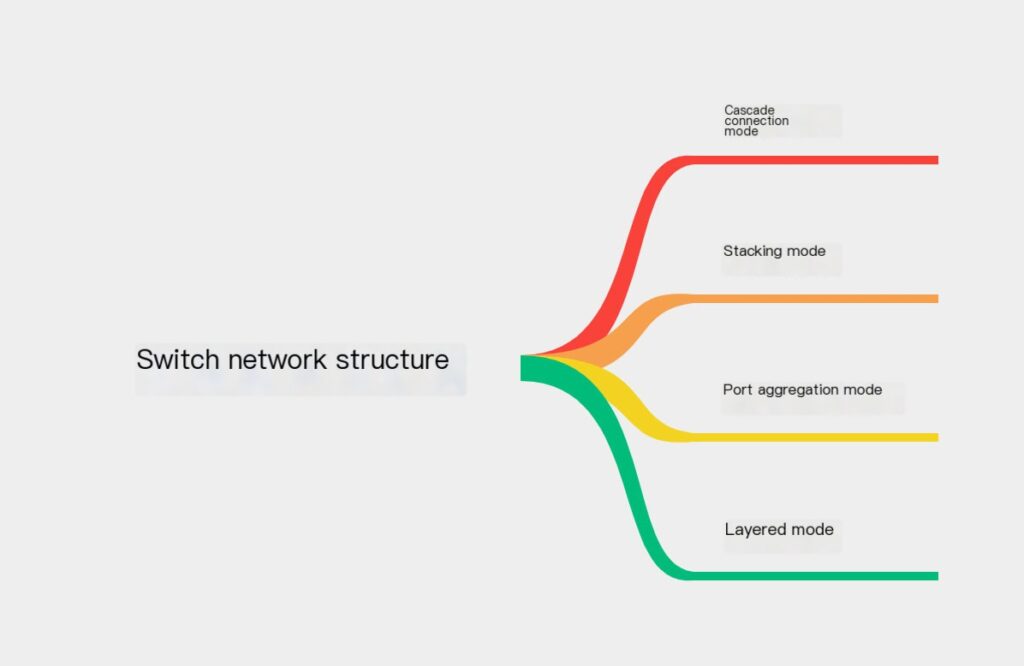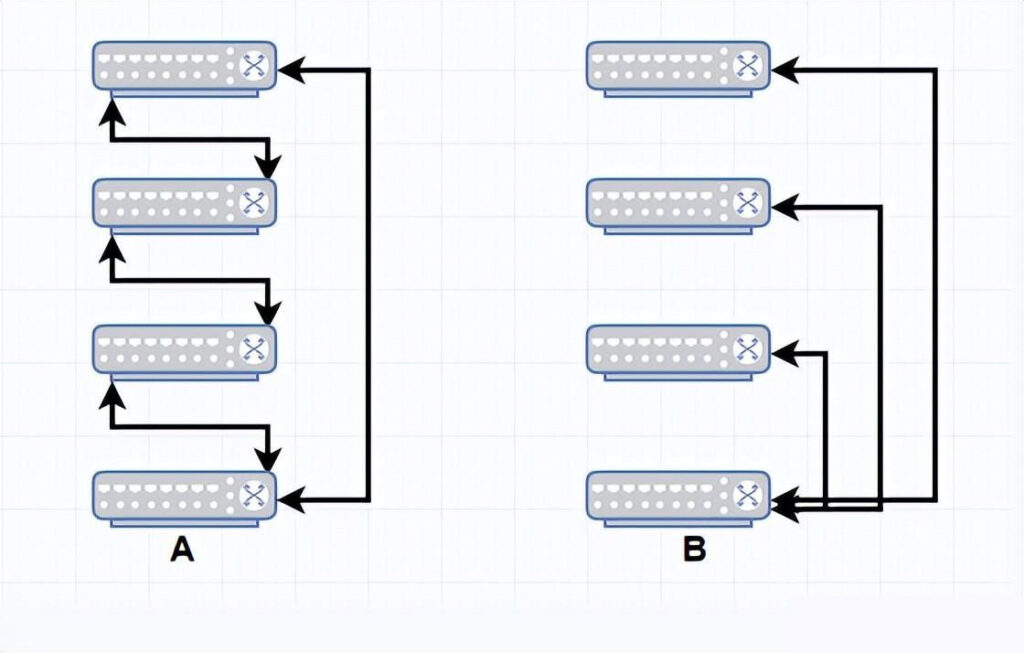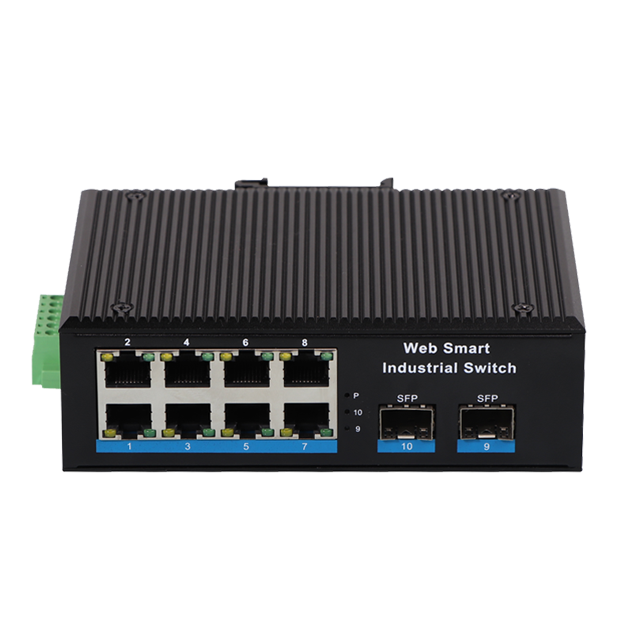Switches are essential devices in computer networks, used for forwarding data between local area networks (LAN) and external computer networks. Switches come equipped with various network structures designed to meet specific network requirements or topologies – cascading, stacking, port aggregation and layering are just four such structures discussed here in detail.

1.Cascading Method

Cascade mode is one of the simplest switch network architecture methods available today. Multiple switches connected through their ports form a cascading network topology in this mode; data travels sequentially amongst them until reaching its final destination.
Cascading offers some advantages over its alternatives for small local area networks; its simplicity and ease-of-use making it well suited to localized networks. Unfortunately, however, cascading also has several drawbacks which may impact performance such as delays when transmitting data across cascading chains that affect network performance; secondly if any link in cascading chain fails it could potentially cause communication interruption throughout all network links resulting in communication interruption across network nodes.
2.Stacking Method

A stacking method is a network structure which connects multiple switches together into an aggregate logical unit through stacking modules or interfaces to form one switch with greater reliability and performance than individual ones could achieve on their own. This approach treats them collectively for management and configuration to provide optimal reliability and performance results.
Stacking provides many advantages to network management and configuration, providing greater reliability and redundancy when one switch fails – the other switches automatically take over its function allowing seamless network switching to continue uninterruptedly. Furthermore, stacking can increase bandwidth and data throughput capacity.
However, stacking has its limitations as well. First off, this approach usually only works with certain models or brands of switches – stacking between brands may not always be compatible – secondly it typically requires special hardware/software support which increases cost and complexity significantly.
3.Port Aggregion Method

Port aggregation is an approach to network design that involves joining together multiple physical ports into one logical one, creating one aggregated port through which data may flow simultaneously through all connected physical ports thereby increasing bandwidth and throughput while at the same time offering redundancy and load balancing benefits.
Port aggregation enhances both network reliability and performance by diverting data through several functioning physical ports if one goes down, helping avoid communication interruptions when one does fail. By redirecting traffic across different physical ports, port aggregation enables load balancing to take place more effectively while improving overall network performance.
However, port aggregation methods require certain precautions for optimal usage. First and foremost, both devices connected to a switch need to support port aggregation for it to work effectively; additionally, configuration and management on the switch add some complexity, with proper adjustment needed in order to prevent loops and data conflicts arising as a result of improper setup or configuration of aggregated ports ensuring optimal use.
4.Layered Approach

The layering approach is a network structure which organizes and deploys switches according to their functional hierarchy, often divided into various levels that each serve distinct tasks or services. A typical layering strategy typically comprises three main layers – core, aggregation and access layers – or levels.
The core layer is at the heart of every network and responsible for handling high data traffic and routing functions. Core layer switches typically offer excellent performance and reliability to connect different subnets or remote networks.
The Aggregation Layer connects the Core Layer with Access Layer for data collection and distribution, typically by way of convergence layer switches that possess high bandwidths with minimal latency lags and bandwidth-limited latency settings; such switches serve to connect various Access Level switches to Core Level switches for maximum connectivity efficiency.
The access layer serves to connect terminal devices directly with switches. Access layer switches usually feature limited ports and lower bandwidth requirements to facilitate connecting computers, printers and other terminal devices.
Layered approaches offer superior scalability, manageability and security benefits. By segmenting network devices according to function it becomes possible to better maintain them for improved network performance and stability as well as flexible security policies which protect it all.
However, the layered approach must also be designed and configured according to specific network needs. Refer back to previous text for differences.
Different network environments and scales may necessitate different levels of quantity and scale; additionally, any layering approach must account for factors like network traffic volume, latency timeframes, redundancies etc. so as to strike an equitable balance between performance and reliability of network systems.

Comparison of Four Modes
- Cascade Method
Features and Advantages of this Approach : Simple, Ease of Implementation and Low Cost are its hallmarks; furthermore it is applicable for small networks.
Disadvantages: Limited Scalability, Complex Network Management & Maintenance and Increased Latency/Complexity are some disadvantages associated with using IP Telephony systems for voice calls.
The cascade method is one of the easiest network structure methods available, enabling data packet transmission by linking together ports of multiple switches into a linear structure. Designed specifically for small networks and with limited scalability when adding additional switches, its complexity and latency increase as more switches must be managed individually. Unfortunately, however, its popularity limits its application beyond small-scale networks due to increased difficulty of network management and maintenance requirements due to each switch having to be managed separately. - Stacking Method : Simplifying Network Management and Configuration, Offering High Bandwidth Connections with Redundant Links Suitable for Medium Size Networks
Disadvantages: High cost. Limited scalability. Increased deployment complexity.
The stacking method involves stacking multiple switches together into a logical unit that is then managed and configured from a single management interface. The stacking method simplifies network management and configuration by enabling administrators to operate all switches at once through one management interface; additionally it supports redundant connections for improved reliability and performance while increasing bandwidth capacity; however its cost may be high as extra modules and cables increase device costs significantly; its scalability may also be limited, thus necessitating special consideration when adding more switches; - Port Aggregation Mode
Features and Advantages : Improve network reliability and redundancy while simplifying configuration and management, increasing bandwidth utilization by simplifying configuration and management processes.
Disadvantages: Compatibility support is necessary, while physical port limitations limit its scalability. Pay special attention when configuring load balancing.
Port aggregation combines multiple physical ports of switches into a logical interface for one aggregation group, increasing network reliability and redundancy; when one physical port fails, data transmission continues through remaining physical ports. Port aggregation makes configuration and management simpler; administrators only need to focus on managing logical interfaces instead of each physical port. Port aggregation also improves bandwidth utilization and speeds and capacities data transmission, but is limited by device compatibility issues and physical port limits. When configuring port aggregation, extra attention should be given to load balancing configuration to ensure data is evenly distributed among physical ports. - Layering Method
Features: Flexible network architecture that facilitates more complex functions. Benefits: Can easily implement more advanced functions. Can apply to large-scale networks.
Disadvantages: Complex deployment and management; higher costs. A hierarchical network structure divides its network into layers, each of which serves a specific function or responsibility. Hierarchy allows for the construction of flexible network architectures and allows more complex functions like routing, security policies and traffic control to take place. It is especially suited to large-scale networks as its structure can be appropriately divided and organized based on user needs. But the hierarchical approach requires significant deployment and management complexity, with more work for configuration and administration needed for its successful deployment. Furthermore, its implementation often necessitates extra equipment and resources which leads to increased costs.
Comparing cascade, stacking, port aggregation and layering methods allows us to understand that each network structure offers advantages and drawbacks; choosing one to best meet our network environment and needs is the key element.
Small-scale networks may opt for cascade or stacking methods of connection and management for easier connectivity and management.
Medium-sized networks should consider stacking or port aggregation to increase both performance and redundancy.
Large-scale networks tend to benefit more from taking an approach with more complex functionality and flexibility, like using hierarchies.
Summary
Switches are key components of computer networks and can adopt various network architectures to meet various network requirements and topology structures. This article presents four such methods of switch architecture design – cascading, stacking, port aggregation and layering.
Cascade networking structure methods provide the simplest network structure solution, making them well suited to small local area networks with limited services; however, they may encounter issues of latency and fault propagation.
Combining multiple switches into a logical unit offers greater reliability and performance; however, certain models and brands may prevent this option from working effectively.
Port aggregation unifies multiple physical ports into a single logical port to maximize bandwidth and data throughput while providing redundancy and load balancing services.
Hierarchical organization organizes and deploys switches according to their functions and levels, offering scalability, manageability, and security while meeting specific requirements for design and configuration.
Selecting an ideal network structure requires taking several factors into account, including network size, performance requirements, reliability needs and management complexity. Based on individual situations these methods of network structure design may be employed comprehensively for creating an efficient, secure computer network.
